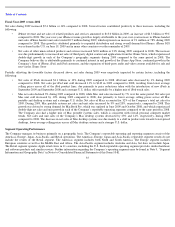Apple 2010 Annual Report Download - page 38
Download and view the complete annual report
Please find page 38 of the 2010 Apple annual report below. You can navigate through the pages in the report by either clicking on the pages listed below, or by using the keyword search tool below to find specific information within the annual report.
Table of Contents
Fiscal Year 2009 versus 2008
Net sales during 2009 increased $5.4 billion or 14% compared to 2008. Several factors contributed positively to these increases, including the
following:
Partially offsetting the favorable factors discussed above, net sales during 2009 were negatively impacted by certain factors, including the
following:
Segment Operating Performance
The Company manages its business primarily on a geographic basis. The Company’
s reportable operating and reporting segments consist of the
Americas, Europe, Japan, Asia-Pacific and Retail operations. The Americas, Europe, Japan and Asia-
Pacific reportable segment results do not
include the results of the Retail segment. The Americas segment includes both North and South America. The Europe segment includes
European countries as well as the Middle East and Africa. The Asia-
Pacific segment includes Australia and Asia, but does not include Japan.
The Retail segment operates Apple retail stores in 11 countries, including the U.S. Each reportable operating segment provides similar hardware
and software products and similar services. Further information regarding the Company’s operating segments may be found in Note 9, “
Segment
Information and Geographic Data” in Notes to Consolidated Financial Statements of this Form 10-K.
35
•
iPhone revenue and net sales of related products and services amounted to $13.0 billion in 2009, an increase of $6.3 billion or 93%
compared to 2008. The year-over-year iPhone revenue growth is largely attributable to the year-over-
year increase in iPhone handset
unit sales. iPhone handset unit sales totaled 20.7 million during 2009, which represents an increase of 9.1 million or 78% during 2009
compared to 2008. This growth is attributed primarily to expanded distribution and strong overall demand for iPhones. iPhone 3GS
was released in the U.S. on June 19, 2009 and in many other countries over the remainder of 2009.
•
Net sales of other music
-
related products and services increased $696 million or 21% during 2009 compared to 2008. The increase
was due predominantly to increased net sales of third-
party digital content and applications from the iTunes Store, which experienced
double-digit growth in each of the Company’
s geographic segments during 2009 compared to the same period in 2008. The
Company believes this is attributable primarily to continued interest in and growth of the iTunes App Store, continued growth in the
Company’s base of iPhone, iPad, and iPod customers, and the expansion of third-
party audio and video content available for sale and
rent via the iTunes Store
•
Net sales of iPods decreased $1.1 billion or 12% during 2009 compared to 2008. iPod unit sales decreased by 1% during 2009
compared to 2008. Net sales per iPod unit sold decreased 11% to $149 in 2009 compared to 2008, resulting from lower average
selling prices across all of the iPod product lines, due primarily to price reductions taken with the introduction of new iPods in
September 2009 and September 2008 and a stronger U.S. dollar, offset partially by a higher mix of iPod touch sales.
•
Mac net sales declined 3% during 2009 compared to 2008, while Mac unit sales increased by 7% over the same period. Net sales per
Mac unit sold decreased by 10% during 2009 compared to 2008, due primarily to lower average selling prices across all Mac
portable and desktop systems and a stronger U.S. dollar. Net sales of Macs accounted for 32% of the Company’
s total net sales for
2009. During 2009, Mac portable systems net sales and unit sales increased by 9% and 20%, respectively, compared to 2008. This
growth was driven by strong demand for MacBook Pro, which was updated in June 2009 and October 2008, and which experienced
double-digit net sales and unit growth in each of the Company’
s reportable operating segments compared to the same period in 2008.
The Company also had a higher mix of Mac portable systems sales, which is consistent with overall personal computer market
trends. Net sales and unit sales of the Company’
s Mac desktop systems decreased by 23% and 14%, respectively, during 2009
compared to 2008. The decrease in net sales of Mac desktop systems was due mainly to a shift in product mix towards lower-
priced
desktops, lower average selling prices across all Mac desktop systems and a stronger U.S. dollar.
























